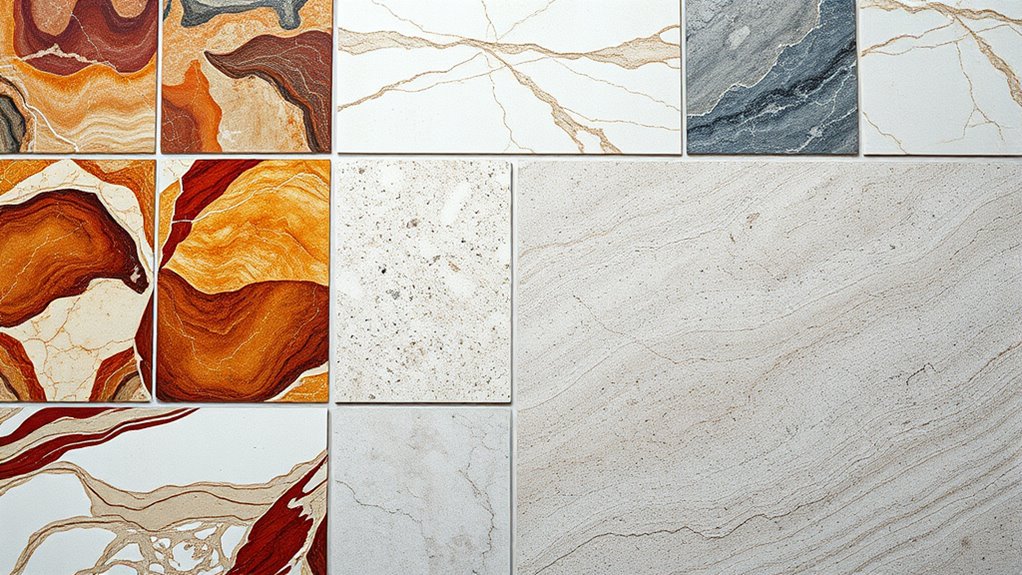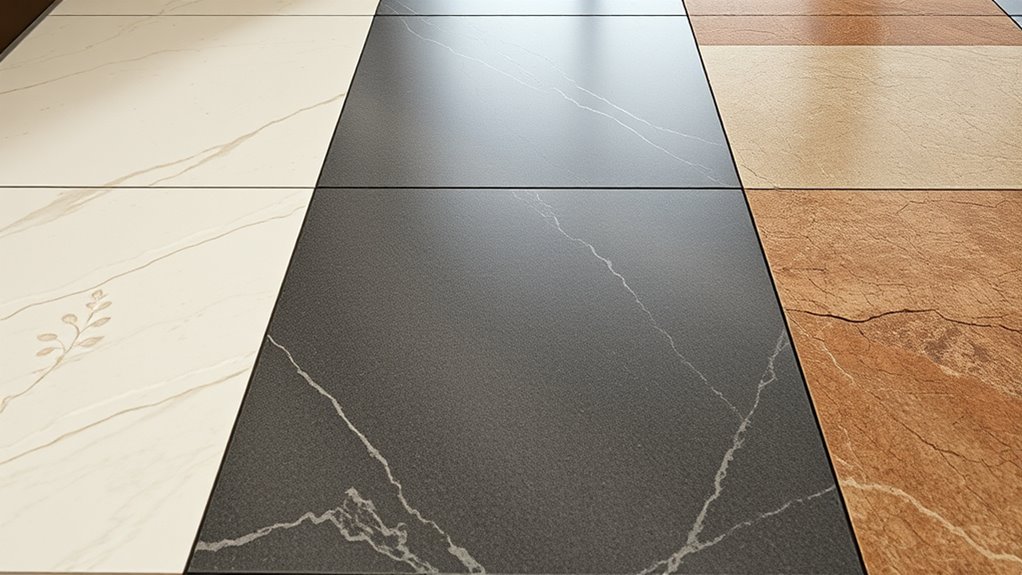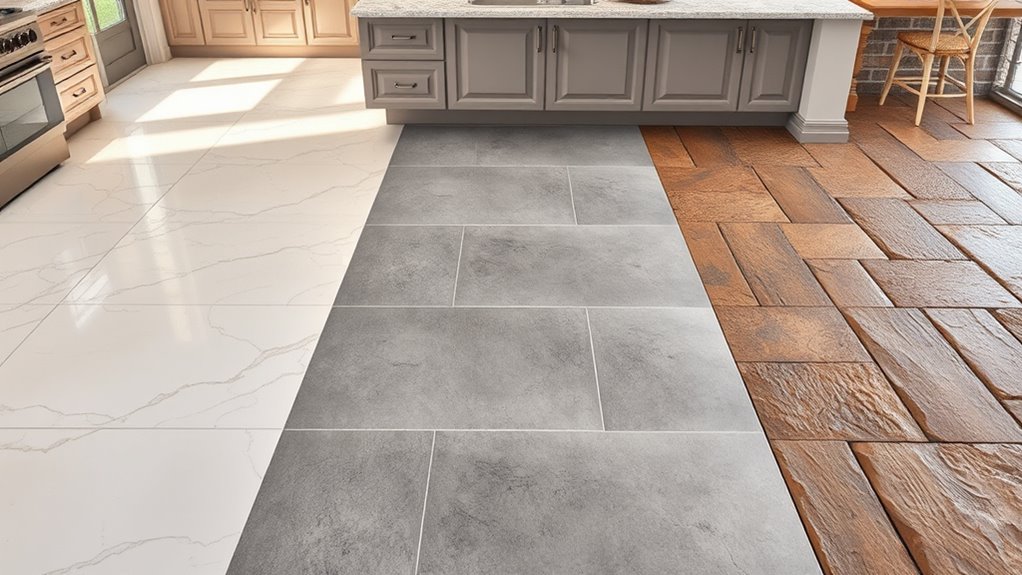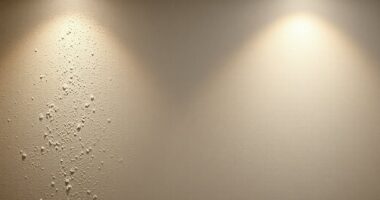When choosing luxury surfaces, your options include ceramic, porcelain, and natural stone tiles. Ceramic tiles offer vibrant colors and creative designs but are less durable, requiring careful maintenance. Porcelain tiles are denser and more resistant to scratches and stains, making them ideal for high-traffic areas. Natural stone tiles provide timeless elegance with unique veining, but they need sealing and more care. Understanding their composition, manufacturing, and aesthetic qualities helps you make the best choice for your space.
Key Takeaways
- Porcelain tiles are denser and more durable, making them ideal for high-end, high-traffic luxury surfaces.
- Stone tiles showcase natural beauty and unique veining, offering a timeless, upscale appearance.
- Ceramic tiles provide vibrant colors and intricate designs, suitable for decorative luxury accents.
- Firing temperature and raw ingredients significantly influence the durability and aesthetic quality of each material.
- Consider maintenance needs, as stone may require sealing, while porcelain and ceramic are easier to clean and maintain.
Composition and Manufacturing Processes

Tile materials are composed of various raw ingredients that determine their strength, durability, and appearance. The raw material sources vary depending on the type of tile you choose. For ceramics and porcelain, clay, feldspar, and silica are primary ingredients. These materials are mixed and shaped before firing at specific temperatures; firing temperature plays a pivotal role in defining the tile’s properties. Higher firing temperatures typically produce denser, more durable tiles with a refined finish. For stone tiles, natural stones like marble, granite, and limestone are quarried directly from the earth, then cut and polished. The manufacturing process involves precise heating and shaping, ensuring each tile’s consistency. Understanding these raw ingredients and firing processes helps you select the right tile for your project’s durability and performance needs. The firing process significantly influences the final appearance and strength of the tiles.
Aesthetic Appeal and Design Options

Are you looking to enhance your space with visually striking surfaces? Tile materials offer impressive aesthetic appeal through diverse color options and pattern versatility. Ceramic tiles often feature vibrant hues and detailed designs, making them perfect for creative expressions. Porcelain tiles provide a sleek, uniform look with subtle color variations, adding elegance to any setting. Stone tiles bring natural beauty with earthy tones and unique veining, creating a timeless appeal. The wide range of pattern options allows you to customize your space, from classic mosaics to modern geometric designs. Whether you prefer bold, eye-catching visuals or understated sophistication, these materials give you the flexibility to achieve your desired ambiance. Your choice of tile material can truly transform your space into a personalized, stylish environment.
Durability and Maintenance Considerations

When choosing tile materials, it’s important to think about their durability and how much maintenance they require over time. Ceramic tiles generally offer moderate scratch resistance but can be more stain susceptible if their glaze is thin. Porcelain tiles excel in both scratch resistance and stain resistance, making them highly durable for high-traffic areas. Stone tiles, like marble or travertine, tend to be softer and more prone to scratches and stains, requiring regular sealing to maintain their appearance. You’ll need to consider cleaning routines; ceramic and porcelain are easier to maintain with simple cleaning agents. Stone surfaces might need special sealants and gentler cleaning, but they can develop a patina that adds character. Additionally, understanding maintenance routines can help prolong the lifespan of your tiles and keep them looking their best. Overall, your choice should balance durability with ease of maintenance for your specific space.
Frequently Asked Questions
Which Tile Type Is Most Environmentally Sustainable?
When it comes to eco-friendly choices, you want a tile that’s a win-win for the environment. Think of it as choosing the lesser of two evils. Porcelain often has sustainable manufacturing practices and eco-friendly finishes, making it a strong candidate. Ceramic tiles also lean toward sustainability, especially if sourced locally. Stone, while natural, can have a higher environmental impact due to quarrying. You’ll want to weigh these factors carefully.
How Do Thermal Properties Differ Among Ceramic, Porcelain, and Stone?
You might wonder how thermal properties differ among tiles. Ceramic tiles generally have lower thermal conductivity, meaning they don’t transfer heat quickly, offering better heat retention. Porcelain tiles typically have higher thermal conductivity, making them good at conducting heat, but they still retain warmth well. Stone tiles vary widely; some, like marble, have high thermal conductivity, while others retain heat longer. Your choice depends on your need for heat transfer or retention.
Are There Health Concerns Related to Any of These Tile Materials?
Thinking about tile toxicity? You should consider indoor air quality and chemical emissions. While most ceramic, porcelain, and stone tiles are safe, some glazed ceramics may emit low levels of volatile organic compounds (VOCs). Choose tiles with low or no VOC emissions to keep your space safe and healthy. Proper ventilation and selecting eco-friendly options help minimize potential health concerns, ensuring your home remains a healthy, hazard-free haven.
What Are the Best Installation Practices for Each Tile Type?
When installing tile, you should follow best practices tailored to each type. Use proper cutting techniques to guarantee precise edges and minimize waste. Grout sealing is essential after installation to prevent moisture and stains, especially for stone and porcelain. For ceramic, sealing may be optional but still beneficial. Always prepare the substrate properly, use the right adhesive, and allow adequate curing time to achieve a durable, professional finish.
How Do Costs Vary Over the Lifespan of Each Material?
You’ll find that cost longevity varies depending on the tile material. Ceramic tiles are budget-friendly upfront but may require more maintenance over time, increasing costs. Porcelain offers better durability and lower maintenance costs, making it a cost-effective choice long-term. Stone tiles have higher initial costs and can be costly to maintain, especially if they need sealing or repairs. Overall, consider both upfront and ongoing maintenance costs when evaluating each material’s value.
Conclusion
Choosing between ceramic, porcelain, and stone tiles is like picking the perfect brushstroke for a masterpiece—you want durability, beauty, and ease of maintenance. Think about your style, how much wear your space gets, and your upkeep preferences. Each material offers unique advantages, so select the one that best fits your vision and lifestyle. When you find the right tile, your surface will shine like a jewel, elevating your space beautifully and effortlessly.









